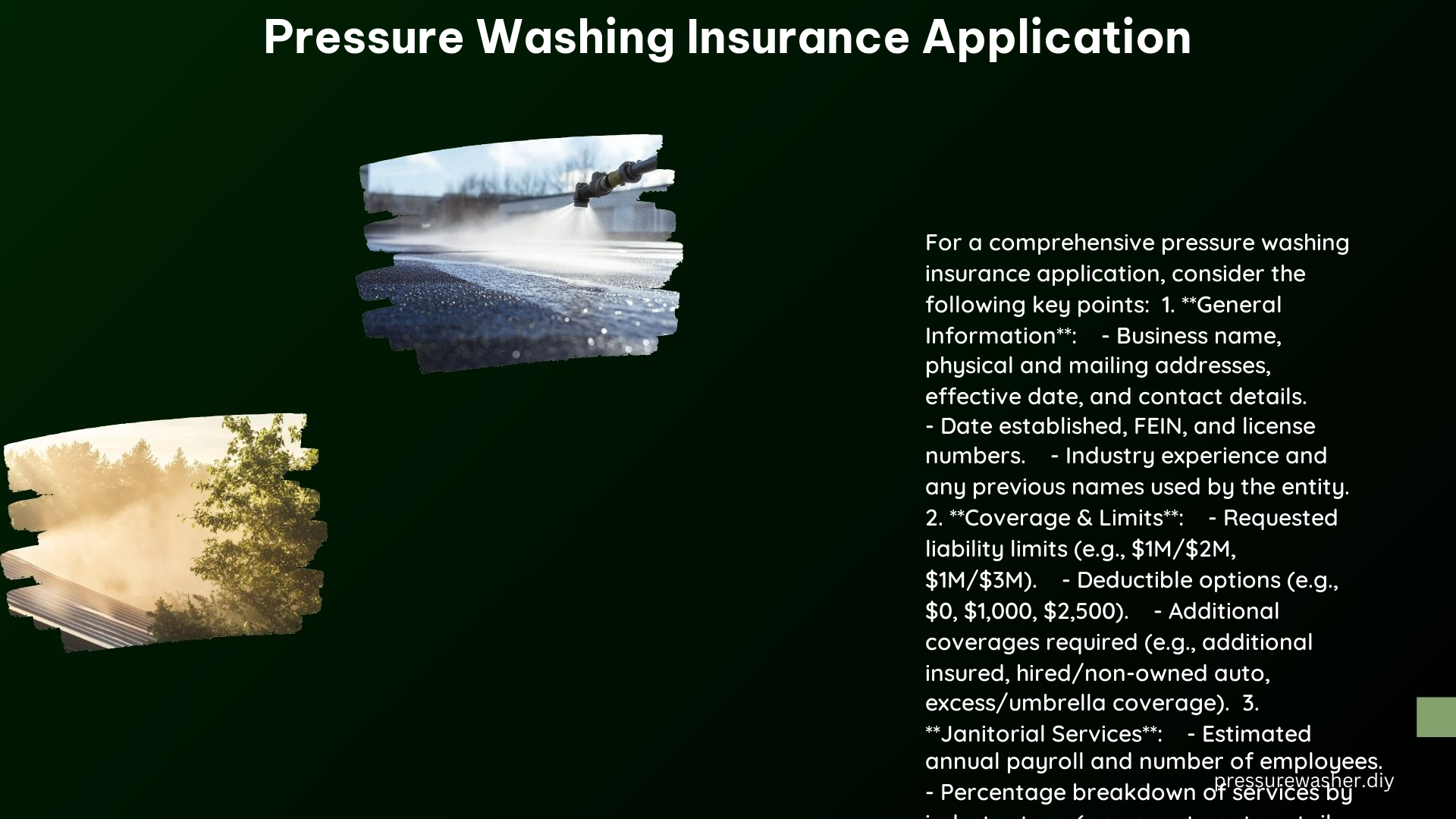Pressure washing insurance applications are a crucial step for businesses in the pressure washing industry to ensure they have the right coverage to protect their operations. This comprehensive guide will delve into the key elements, steps, technical specifications, and costs involved in a pressure washing insurance application.
Key Elements of a Pressure Washing Insurance Application
1. General Information
- Business Name and Address: The full legal name of the business and its physical address, including the city, state, and zip code.
- Contact Person and Details: The name, phone number, and email address of the primary contact person for the insurance application.
- Effective Date and Expiration Date: The desired effective date of the insurance coverage and the current expiration date of any existing policies.
- Establishment Date and Identification Numbers: The date the business was established, as well as the Federal Employer Identification Number (FEIN) or any relevant license numbers.
2. Coverage and Limits
- General Liability Limits: The requested limits for general liability coverage, typically expressed as $1M/$2M or $1M/$3M.
- Deductible: The deductible amount the business is willing to pay, such as $0, $1,000, or $2,500.
- Additional Coverages: Any additional coverages required to fulfill client contracts, such as additional insured, employee benefits liability, or hired/non-owned auto.
3. Janitorial Section
- Estimated Annual Payroll: The estimated annual payroll for the janitorial services portion of the business.
- Number of Employees: The number of full-time and part-time employees involved in the janitorial services.
- Service Breakdown: The percentage breakdown of janitorial services by industry type (e.g., commercial, residential) and operation type (e.g., pressure washing, window cleaning).
4. Operations and Safety
- Use of Scaffolds or Rigging: Whether the business utilizes scaffolds, lifts, or other rigging equipment for pressure washing operations.
- Safety Procedures: The procedures in place to prevent slips and falls, handle hazardous materials, and protect customer keys or other property.
5. Claim History
- Prior Policy Information: Details about the business’s previous insurance policies, including the carrier, premium, payroll, deductible, and any incurred losses.
- Past Claims: Any claims made in the last five years, including the nature of the claim and the amount paid.
- Potential Future Claims: Any known incidents or situations that could lead to future claims.
Steps to Get a Quote for Pressure Washing Insurance

-
Complete an Online Application: Fill out a detailed application form that includes the key elements mentioned above. This can be done through insurance providers like NEXT Insurance, Insureon, or AmTrust Financial.
-
Compare Quotes: Receive quotes from multiple insurance carriers based on the information provided in the application. Compare the quotes to find the best coverage and pricing for your business.
-
Purchase and Download a Certificate of Insurance: Once you have chosen a policy, pay for it online. Download a certificate of insurance (COI) to prove your coverage and provide it to clients as needed.
Technical Specifications and Costs
Typical Costs
The cost of pressure washing insurance can vary significantly based on several factors:
- Business Size: Larger businesses with more employees and higher revenue will typically pay higher premiums.
- Number of Employees: The more employees a pressure washing business has, the higher the insurance costs will be.
- Type of Work: Businesses that perform more high-risk pressure washing services, such as working on tall buildings or using hazardous chemicals, will generally pay higher premiums.
As a general guideline, a small pressure washing business with a few cleaners may pay between $1,000 to $3,000 per year for their insurance coverage, while a larger, more complex operation could pay upwards of $10,000 or more.
Technical Specifications
Pressure washing insurance policies typically include the following coverage types:
- General Liability: Protects the business from claims of bodily injury, property damage, and personal/advertising injury.
- Contractors’ Errors & Omissions (E&O): Covers claims related to professional errors or negligence in the pressure washing services provided.
- Commercial Auto: Provides coverage for any vehicles used in the pressure washing business, including liability, collision, and comprehensive.
- Tools and Equipment: Covers the cost of repairing or replacing pressure washing equipment, tools, and other business property.
- Commercial Property: Protects the business’s physical location and assets, such as the building, inventory, and office equipment.
The specific limits, deductibles, and additional coverages included in a pressure washing insurance policy can be customized to meet the unique needs of each business.
References
- NEXT Insurance. (n.d.). Pressure Washing Insurance: Buy Affordable Coverage | NEXT. Retrieved from https://www.nextinsurance.com/business/pressure-washing-insurance/
- AmTrust Financial. (n.d.). Janitorial Services Supplemental Application. Retrieved from https://amtrustfinancial.com/getmedia/02b2edb6-fada-492e-9756-a3e564a5dae2/ANA_E-S_Janitorial_Services_Application_MKT0113_fillable
- ExecIns. (n.d.). Pressure Washing Supplemental Application. Retrieved from https://www.execins.com/documentlibrary.aspx?ID=24519
- Insureon. (n.d.). Pressure & Power Washing Insurance: General Liability & More. Retrieved from https://www.insureon.com/cleaning-business-insurance/pressure-washing
- RLI Corp. (n.d.). General Liability Insurance Application For Janitorial Services. Retrieved from https://www.rlicorp.com/sites/default/files/pdf/janitorial-app.pdf
